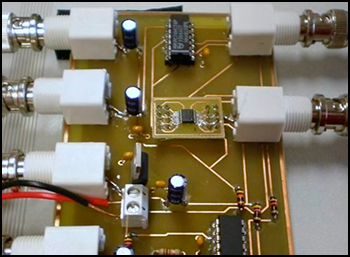Electronic Components and Circuits

Course introduction
_____________________________________________________________________________________
 Image courtesy of the authors of the course |
Electronic Components and Circuits
JOSÉ ANTONIO GARCÍA-SOUTO
|
21 Hours of Lectures
24 Hours of Group Class and Evaluation
6 Hours Laboratory work
135 Hours Total Learning Effort
PRERREQUISITES AND RECOMMENDED PREVIOUS KNOWLEDGE
Knowledge on Circuits Theory and Linear Systems.GENERAL DESCRIPTION OF THE COURSE
Operating principle, models and applications of basic semiconductors electronic components (diodes, bipolar transistors and field effect transistors), including the bias circuits. In addition, the concepts related to electronic analog amplification stages (small signal gain, input and output impedances and frequency response). Finally, the characteristics of operational amplifiers (OA) as analog integrated circuits and some of the most important AO applications.
The course is structured into four main modules developed through individual sessions (lectures and group classes) in a monograph devoted to each section of them:
- Introduction: fundamentals and previous notions of electronic signals and circuits, components, instrumentation and measurements.
- Basic Electronic Components: Semiconductors, diodes, bipolar transistors and field effect transistors.
- Electronic Amplification: Single-stage amplifiers, multi-stage amplifiers and frequency response.
- Operational Amplifier and Applications: ideal OA, real OA, analysis of linear and nonlinear applications of the OA.
OBJECTIVES: KNOWLEDGE AND SKILLS
This course enables students to understand the operation of basic electronic components, to analyze electronic circuits that include them and to use these components in electronic systems of analog signal conditioning and signal processing. An important skill is through the simulation of basic electronic assemblies as a complement to the implementation of measurements in the laboratory.
After the course the student should be able to solve basic problems (case studies) involving electronic components and circuits that would include design of the biasing circuitry, evaluation of amplification parameters, transient regime and frequency response, characterization of electronic circuits (simulation and measurements) and comparison with the datasheets.
TEACHING MATERIAL
The teaching material is organized in monographic sessions:
- 14 lectures
- 14 group work sessions (3 evaluation sessions included)
Additional exercises and practical guides:
- 4 modules of introduction exercises
- 6 modules of 3 evaluation exercises
- 3 guides of simulation and laboratory work
PRACTICAL ASSIGMENTS AND ASSESSMENT ACTIVITIES
The evaluation is based on 3 exams along the course, the proposed practical cases that the student solves and presents in a writing document (complemented with simulations) and the practical implementation in the laboratory.
The first two partial tests are performed at the end of a consistent thematic block. In addition, the student must do the problems selected for this block. Evaluation of thematic block 1 and 2 are 20% and 30% of the final grade, respectively. A Final exam evaluates the thematic block 3 and a case study that involves overall contents of the course (30%). The laboratory work is evaluated through the practical implementation of some electronic circuits working in groups and the final report of each session (20%).